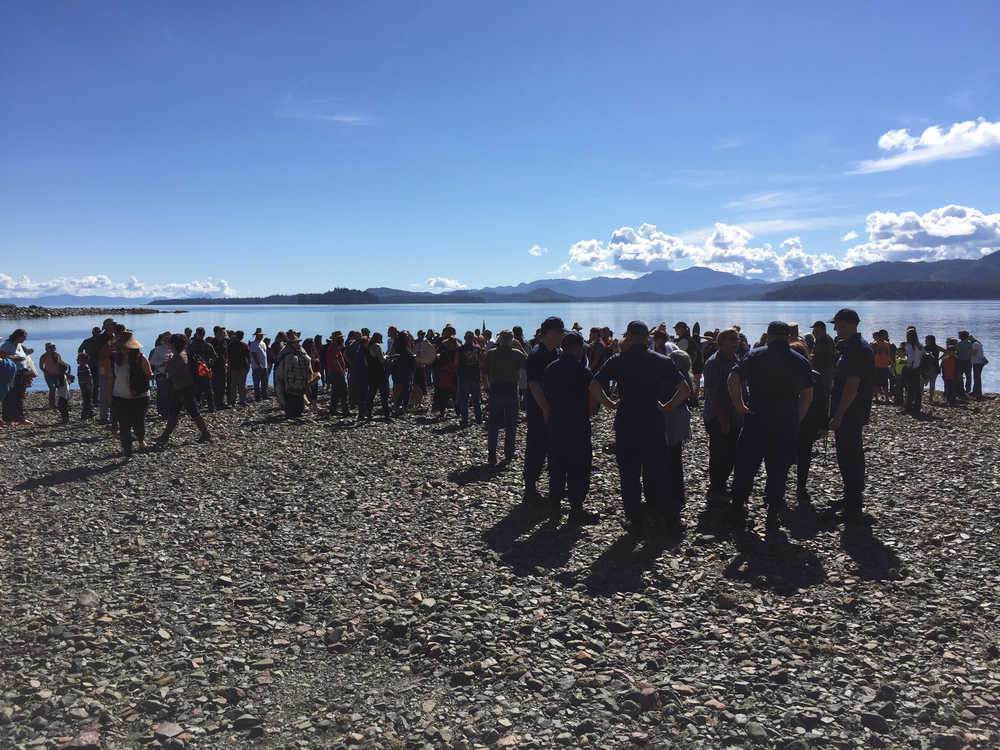As the morning of Sept. 3 broke warm and clear over the village of Kasaan, a small southeast Alaskan village of approximately 50 year-round residents, a sense of excitement and celebration — along with laughter, music, and the sound of carving tools on wood — filled the air. Carver Gitajang (Glenn “Stormy” Hamar) along with apprentice carvers St’igiinii (Harley Holter), Nang K’adangaas (Eric Hamar), and Wooshdeiteitxh (Justin Henricks) were in the carving shed, preparing for the rededication of Náay í’Waans (The Great House), better known as the Chief Son-i-Hat Whale House.
“It (Náay í’Waans) is our history and connects us to our heritage, our ancestors, and means everything to the people and to the village of Kasaan,” said Gitajang.
Prior to the past three years of reconstruction, the longhouse, built in 1880, was subject to insects, adverse weather and vandalism. Gitajang and his crew have replaced rotting and weakened poles, planks, and roofing, carefully restoring Náay í’Waans to its traditional beauty and strength. They’ve used as much of the original longhouse as possible.
As the day progressed, nearly 1,000 visitors began to make their way from Kasaan to Náay í’Waans, a leisurely stroll along a sun dappled trail, to meet canoes from Kasaan, Klawock, Ketchikan, and as far away as Juneau. St’igiinii ran briskly along the trail, calling out greetings to guests as he raced to meet the first of them.
St’igiinii has worked tirelessly on Náay í’Waans. Many who call him nephew or friend have heard his laughter in the carving shed or through the forest. On Sept. 3, however, he was serious when he spoke of what the longhouse means to him. “Náay í’Waans was a beacon of hope to the people of Old Kassan,” he said. (A century ago, many people moved from Old Kassan, on Skowl Arm, to Kasaan for jobs and the school.) “It was built to preserve and protect the Haida culture. And today it still serves as that beacon of hope to this community. It still preserves and protects the Haida culture and connects us to our ancestors.”
That morning, a young voice announced the sighting of the first canoes as they rounded the point into the small bay in which Náay í’Waans sits, its main entrance facing the beach. People began to fill the beach as the canoes paddled closer to shore. Both those on water and on shore sang traditional songs as each canoe passed the beach, allowing the standing Chief Son-i-Hat, John McAllister, to recognize them before they gathered off shore and waited to be recognized. (Kóyongxung was the original Chief Son-i-Hat, a wealthy Haida chief and the man who commissioned Náay í’Waans; he died in 1912.)
Standing Chief Son-i-Hat’s voice sounded across the water as he identified each of the canoes and granted them permission to land upon the shore before Náay í’Waans. Those on land sang them in, and St’igiinii waded into the water to help the crews disembark and join those gathered on the gravelly beach. People sang songs of celebration and welcome as they walked the canoes up the shore with the rising tide; guests and locals filled the area around Náay í’Waans. As the grand entrance began, dance groups from Hydaburg, Klawock, Ketchikan, Juneau, and Haida Gwaii (formerly the Queen Charlotte Islands), circled the longhouse, singing and dancing as they entered. Their voices and drums filled the air and drifted through the trees.
Haida elder from Kasaan Julie Coburn gave opening prayers and recognition to Taslaanas, the bear clan of Kasaan. Then Anthony “Tony” Christianson, mayor of Hydaburg, and Chalyee Éesh (Richard Peterson), President of Central Council Tlingit and Haida Indian Tribes of Alaska, who is from Kasaan, took over the duties of announcing the speakers for the event.
Speakers included Lt. Gov. Byron Mallot, Kavilco Incorporated president Louis Jones Sr., Organized Village of Kasaan tribal president Ronald Leighton, City of Kasaan mayor Della Coburn, Rasmuson Foundation representative Jason Smart, Skidegate Traditional Chief Russ Jones, and Chief Son-i-Hat descendant Clinton Cook Jr.
As the speeches ended guests began to make their way back toward Kasaan, where an evening of celebration awaited before the recently opened Totem Trail Café. Kasaan community members and volunteers had been preparing throughout the day, cooking and setting up seating for their guests. They filled long tables with traditional foods: salmon, halibut, venison, and more, along with endless pots of hot coffee and strong tea.
As dance groups from around Southeast Alaska and Haida Gwaii sang and danced, gifts of carved panels, woven cedar hats, headdresses, and regalia were given to honored guests while gifts of t-shirts, jams, honey, jarred salmon, jewelry, posters, clothing, and many other items were given in thanks to all that attended.
And as the sun set on Náay í’Waans and the village of Kasaan, the carvers had been honored, respect had been given to all who had made this historic event possible and Náay í’Waans, The Great House, often known as the Chief Son-i-Hat Whale House stood, restored, in the brilliant glow of the setting sun, a continued beacon of hope for the preservation and protection of the Haida culture and a testament of strength and unity.
***
The traditional Haida longhouse restoration project was made possible through the partnership of the Organized Village of Kasaan (OVK), Kavilco Non-Profit, and the Kasaan Haida Heritage Foundation. The efforts were also aided through funding from the Rasmuson Foundation as well as donations of timber from Sealaska Corporation, The U.S. Forest Service, and the Alaska Mental Health Trust Authority.
• Quinn Aboudara is a lifelong resident of Prince of Wales Island and can often be found wandering the woods and waters of his home. He may be contacted at the Sustainable Southeast Partnership office of the Klawock Cooperative Association or by email: kcacatalyst@klawocktribe.org

